Naked Dead Cats Bigfooty 2016
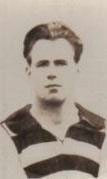
145 games 10 goals
1929-30, 1932-34 Geelong 80 (48-31-1)Arthur Coghlan gloried in the nickname 'Bull' and was renowned as one of the toughest players of his generation. Geelong recruited him from Toora and he made his VFL debut, the first of 145 appearances, in 1922. A controversial suspension in 1925 cost him his place in Geelong's historic first VFL premiership team, but he played when the Cats next went top six years later. Coghlan was selected to captain the VFL's interstate side in 1929. Most commonly used as a hard-hitting, bullocking ruckman, 'Bull' Coghlan was equally at home in a key position. The archetypal team player, he combined particularly well with fellow ruckman Len Metherell, and was continually to be heard shouting encouragement to the younger players in the team.
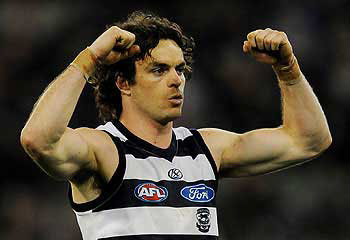
284 games 17 goals
Scarlett was selected by Geelong with the 45th overall pick in the 1997 AFL Draft under the father-son rule, and made his senior debut for the club in the final round of the 1998 AFL season. Scarlett plays predominantly as a fullback, and has garnered a long list of individual accolades. He is a triple premiership player from Geelong's premiership-winning teams of 2007, 2009 and 2011, has won a Carji Greeves Medal and been selected to six All-Australian sides, the most selections for a Geelong player. As well as this, Scarlett has been inducted into the Geelong Football Club Hall of Fame, represented the Victorian state team in the AFL Hall of Fame Tribute Match and represented Australia in International rules football.
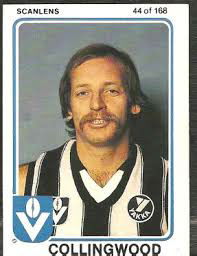
219 games (17 Geelong) 17 goals
Defender Ray Byrne had the singular misfortune to play in no fewer than four losing VFL Grand Final teams, one with Carlton and three with Collingwood. He commenced his league career with the Blues, whom he joined from Golden Square, in 1973, and his debut season culminated in his first losing Grand Final appearance, against Richmond. Over the course of his five-and-a-half season, 81-game stint with Carlton he developed into a highly resourceful and dependable permanent back pocket.
After crossing to Collingwood midway through the 1978 season he further enhanced his reputation during another five-and-a-half season stint which yielded 121 senior appearances. Included among these were the losing Grand Finals of 1979 against Carlton, 1980 against Richmond, and 1981 against Carlton once more. Byrne's last port of call was Geelong, for whom he added a final 17 VFL games in 1984.
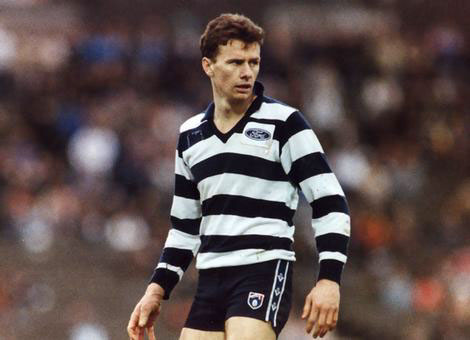
132 games (121 Geelong) 79 goals
After failing as a forward with Fitzroy, where he played 11 VFL games and kicked 20 goals in 1987-88, Ken Hinkley was reborn at Geelong as a dynamic, rebounding defender of the highest echelon. Polished and precise in everything he did, Hinkley won a best and fairest with the Cats in 1992 where he was also 3rd in the Brownlow medal, and was selected in the 1991 and 1992 AFL All Australian teams. He played in three losing Grand Finals for Geelong, with the last of his 121 games for the club being the premiership decider of 1995 against Carlton.
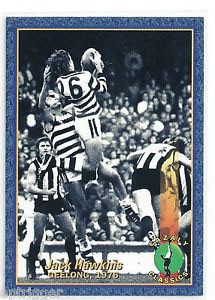
182 games 20 goals
Hawkins made his Victorian Football League (VFL) debut against Collingwood in Round 3 1973 and immediately became a leading player for Geelong. Hawkins had his most successful season in 1976, playing 24 games and polling 24 Brownlow Medal votes, finishing twelfth behind winner Graham Moss. Hawkins was known as 'Jumping Jack' for his incredible vertical leap when jumping for a mark. He also won the State High Jump competition.
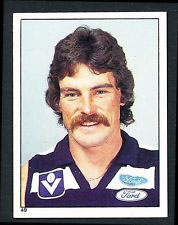
110 games 4 goals
Recruited from Morwell, Geelong's Ray 'Swap' Card was one of the best negating footballers of his generation. Tough, resolute and durable, he was renowned for his ability to keep the opposing team's best attacking players quiet. Most of his 110 VFL games between 1977 and 1987 were played on a half back flank, but later in his career he also added an attacking dimension to his game, which enabled him to perform effectively in other positions. He won the Cats' best and fairest award in 1983.
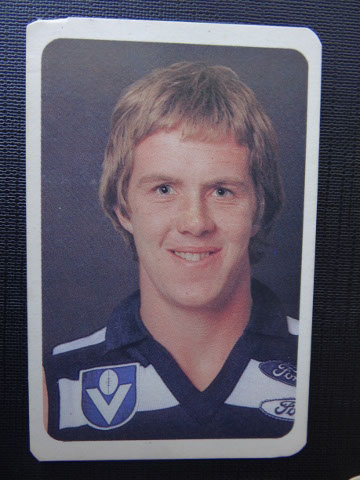
154 games 57 goals
Mark Yeates overcame the setback of sustaining a hamstring injury whilst executing his first kick in league football to develop into a highly valuable performer for Geelong for more than a decade. That debut match took place in 1980, and when he retired at the end of the 1990 season he had amassed 154 games in a Cats jumper, and kicked 57 games. Capable of producing effective football in any key position, he was most commonly used at centre half back. During the opening moments of Geelong's 1989 grand final loss to Hawthorn he felled Hawks star Dermott Brereton with a ferocious bump, and it is probably this act above all for which he is best remembered.
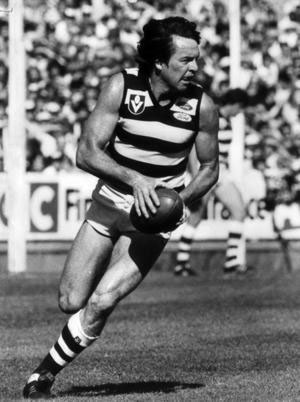
332 games (197 WAFL, 93 Geelong), 271 goals (79 Geelong)
After playing consistently well during the second half of 1979 and throughout 1980 - during which year he was selected to represent Victoria against his home state in a so-called "State of origin" match - Featherby's performances reached a new level of excellence during a 1981 season that saw him claim the Cats' best and fairest award. In one noteworthy match against Melbourne on the MCG he garnered no fewer than 43 kicks, effected eight handballs, and held a dozen marks.
A player with superb stamina and long, loping strides, Featherby upped the pressure as he ran continuously, covering much of the ground and displaying what modern coaches call “a huge engine”. A will-o-wisp player, Featherby had the ability to run and bounce the ball without error and he gathered possessions in big numbers as he played wide of his midfield rival. While there were question marks over his disposal, his floating drop punts strangely enough landed right on target most of the time.
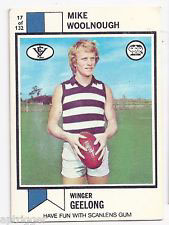
141 AFL games (117 Geelong) 50 goals (42)
Originally from St Joseph's, Mike Woolnough made his senior VFL debut for Geelong in the second round of the 1971 season away at South Melbourne, but a succession of injuries prevented him from establishing a regular place in the side until the middle of the decade. A courageous type, he always went in hard for the ball, and was a capable mark. He spent eight seasons with the Cats, playing 117 games and kicking 42 goals. In 1979 he transferred to Collingwood where he added a final 24 games plus a couple of goals in two seasons. He was a member of the Magpies' losing grand final side against Richmond in 1980 in what proved to be his last ever VFL game.
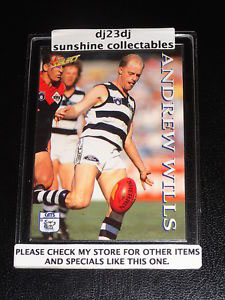
148 AFL games (59 Geelong) 127 goals (43)
Andrew Wills kicked the point that put Geelong level with North Melbourne in the 1994 Preliminary Final before Gary Ablett marked and kicked the winning goal after the siren.
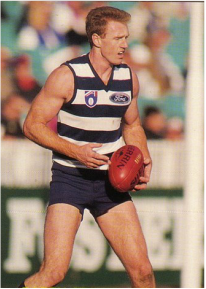
241 games 223 goals
An extremely athletic player who was particularly strong in the air, Geelong's Barry Stoneham was a mainstay of the club for fifteen seasons, during which time he played 241 V/AFL games and kicked 223 goals. Recruited from St Joseph's, he made his Cats debut in 1986, and rapidly developed into the team's 'spare parts' player, capable of doing a job in any key position, or in the ruck. At his peak during the early 1990s, Stoneham won a club best and fairest award in 1990, and achieved AFL All Australian selection two years later. In 1994, however, he suffered a double leg fracture which kept him out of the game for eighteen months, and when he returned, although he was still a valuable player, some of the athleticism and verve had irretrievably gone. He struggled on heroically until the 2000 season, when he finally decided to call it a day.
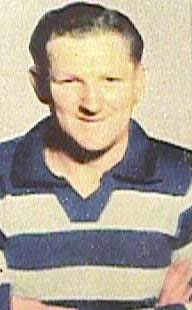
81 AFL games (71 Geelong), 0 goals
Known evocatively as 'The Tank', Don Bauer knew only one way to play the game: hard,direct, uncompromising and unremittingly physical. Only 178cm in height, he was nevertheless powerfully built at 87kg, most of which was sheer muscle. He began his league career with a brief, ten-game stint at Footscray in 1943, but it was at Geelong, where he added 71 VFL games between 1945 and 1949, that he truly blossomed into a player of the top rank.
Capable of playing on either the half back or half forward line with equal effectiveness, he was one of the few players of his time capable of genuinely intimidating opponents, albeit normally within the rules of the game. In addition to his renowned physicality he had good all round skills and drop kicked the ball superbly.
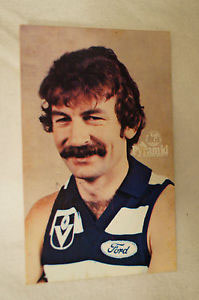
102 games 112 goals
Sheehan played 102 games for Geelong over nine seasons, but only managed 16 senior games in his final three seasons. During this time, however, he won three consecutive reserve grade premierships, captaining the side in 1981.
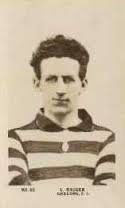
174 games 389 goals
A durable, clever and often spectacular key position forward, Lloyd Hagger was particularly renowned for his ability to kick goals from almost any angle, with either foot. He was also known to have a penchant for talking incessantly on the field.
Hagger made his Geelong debut in 1917 after being spotted playing for Barwon Thirds by Bert Rankin. He played just five games in his debut season, but from 1918 he was a virtual ever-present until he retired, after a total of 174 VFL appearances, midway through the 1929 season.
Carved out of the same mould as Gary Ablett senior, Lloyd Hagger thought nothing of hurling himself headlong over the top of a pack in a - frequently successful - bid to mark the ball. He was at full forward in Geelong's 1925 premiership-winning side, booting two goals, and he topped the VFL goal kicking list the same year. He was the Cats' leading goal kicker on four occasions.
A regular interstate player (12 games), he represented the VFL at the 1921 Perth and 1924 Hobart carnivals.
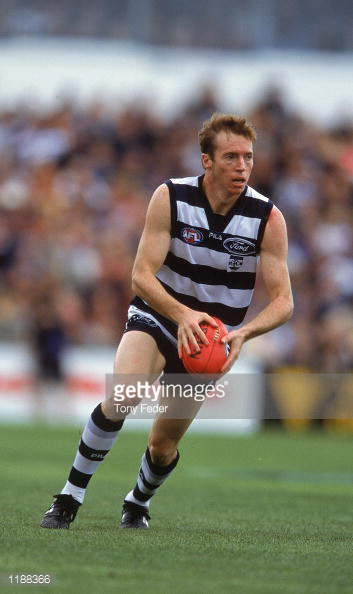
94 AFL games (61 Geelong) 99 goals (75)
Houlihan made a name for himself as a talented half forward, kicking five goals in several games. He managed 14 games in his debut season but just one the following year after a series of injuries. He played two games early in 1999, having little impact. He returned to play all the final eight games and established himself in 2000, playing 22 of 23 games and a top 10 Best and Fairest finish. But after playing 12 of the first 13 games in 2001, his form fell away, playing just two more games and he was then delisted.
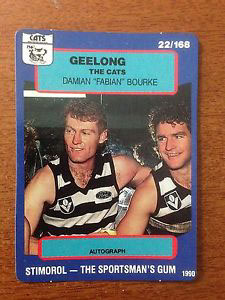
124 AFL games (102 Geelong) 19 goals (15)
Bourke played as a ruckman and captained Geelong from 1987 until 1989. His last game as captain was the 1989 VFL Grand Final where Geelong lost to Hawthorn by a goal. Bourke finished equal eighth in the 1991 Brownlow Medal and in 1993 moved to Queensland to play for Brisbane.
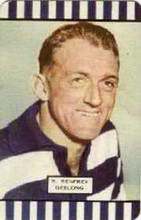
201 games 165 goals
Known as 'Hooker', Geelong's Russell Renfrey was a tough, durable follower whose consistency is evidenced by the fact that he was never once selected for the reserves. Not tall for a ruckman at just 180cm he was nevertheless extremely adept at using his body to maneuver himself into prime position to win the tap, and he rarely lowered his colours over the course of an entire game. Later in his career he moved from being a knock ruckman in the traditional sense to a more modern ruck-rover type, à la Barassi. Renfrey was selected to represent the VFL in 1948, and was a key figure in the Cats 1951 and 1952 premiershipwinning teams. Originally recruited from Drysdale in the Geelong and District Football League, he played 201 VFL games for Geelong between 1946 and 1956, booting 165 goals.
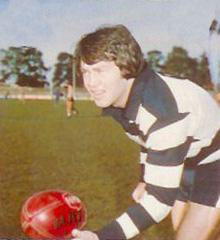
67 games (238 WAFL) 47 goals
Armadale boy Bryan Cousins made his league debut with Perth in 1970, the same season that saw him win the club's fairest and best trophy at reserves level, and went on to become one of the club's most noteworthy and respected performers. Dynamic, pacy and a penetrative kick, he won the Demons' fairest and best award in 1972, and played in the centre in the losing Grand Final of 1974 against East Fremantle. In 1975 he moved to VFL club Geelong where he spent five seasons and played 67 games, many of the best of them in his final year. He continued to play good football when he returned to Perth in 1980 although he had had the bad fortune to miss the club's halcyon spell of the late 1970s. He won a second club fairest and best award in 1982, the same season that saw him assume the senior team captaincy, a role he retained for three years.
In 1983 he lost the Sandover Medal to East Perth's John Ironmonger on a countback; 14 years later he joined all other such runners-up in being awarded a retrospective Medal by the Westar Rules authorities. Cousins continued playing with the Demons until 1987, by which time he had amassed 238 senior games for the club. After playing as a centreman or on-baller for the majority of his career, he developed into a solid, rebounding back pocket player in his later years. Somewhat surprisingly, Bryan Cousins made just one interstate appearance for Western Australia, against South Australia at Subiaco in 1985.
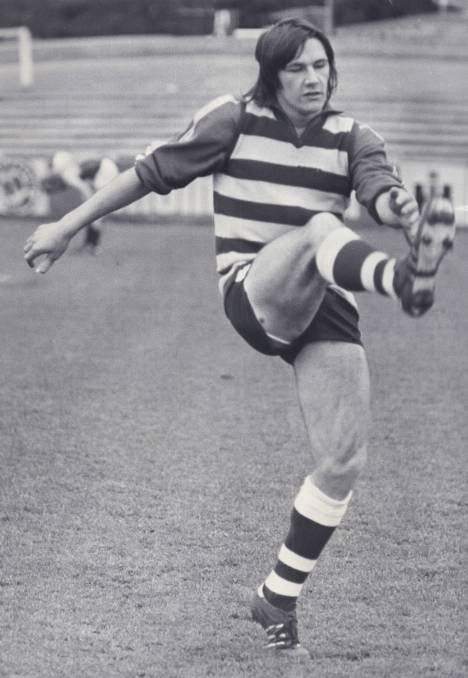
58 games 2 goals
Woodman was a defender from Bannockburn who played mostly as a centre half-back and in the back pocket.He had one of his best games in Geelong's semi final against North Melbourne in 1976, with 23 disposals, but finished on the losing team. In 1978 he appeared in 21 games, the most he would play in a single season.
In 1982 and 1983, Woodman won the Hampden Football League's Maskell Medal, while playing with Camperdown. He was the first player to win the award back to back since George Swarbrick in the 1950s, another Geelong footballer. Alan also played locally with Grovedale, St Albans, Barwon and Winchelsea; however Alan is held in high regard with the Bannockburn Tigers named as their Captain in the Team of the Century (Alan guided the Tigers to their first flag in over 50 years in 1990). Alan promised the club that he would return someday after he was picked up by the Cats (VFL/AFL). Alan was one of Geelong's toughest footballers who was hard on his players and himself; he once played out a game with a broken jaw whilst at Grovedale and had his jaw wired up at hospital after playing out the remainder of the match.